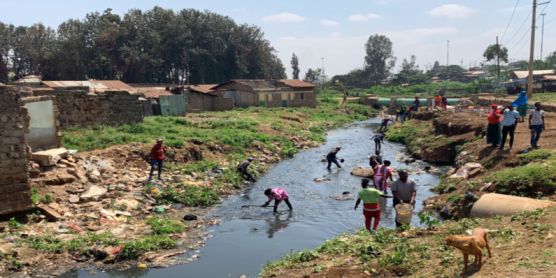Nairobi's informal settlements and schools are set to see a drastic improvement in sanitation as the second phase of the Nairobi Rivers Rehabilitation and Restoration Programme (NaRSIP II) nears its completion.
The initiative, launched in collaboration with the Kenyan Government and the African Development Bank (AfDB), is making strides in expanding the city's sewerage infrastructure.
The programme has already resulted in the construction of 440 kilometers of primary and secondary sewer lines, which now link up with the trunk sewers established during the first phase.
Additionally, 38 kilometers of tertiary sewers have been laid, and over 4,000 household connections have been completed.
This expansion is expected to benefit at least 250,000 people in areas like Kahawa West, Githurai, Mwiki, and Clayworks.
"The main motivation of the NaRSIP program is to ensure that wastewater from domestic and industrial sources is collected and treated for a cleaner environment," explained Eng. Joseph Kamau, CEO of the Athi Water Works Development Agency, which is overseeing the implementation of the programme.
In addition to improving infrastructure, NaRSIP II is also working towards the restoration of key Nairobi rivers, including the Nairobi, Ngong, Mathare, and Riara rivers.
These efforts are designed to reduce pollution and improve the overall health of the city's ecosystems. This is expected to have long-term positive effects on both the environment and the economy, particularly in communities living downstream, such as those near Thwake Dam.
Principal Secretary in the State Department for Water and Sanitation, Julius Korir, highlighted how NaRSIP II aligns with the national Vision 2030 goals.
"NaRSIP aligns squarely with the Vision 2030 objectives, which is 100 percent provision of clean water and dignified sanitation for all Kenyans by the year 2030," he said.
A crucial aspect of the project is the ongoing work at the Dandora Estate Sewage Treatment Plant in Ruai.
Currently, the plant is 90 percent complete and is set to double its capacity from 160,000 to 320,000 cubic meters of waste treated daily.
Upon completion, the plant will handle approximately 80 percent of Nairobi's domestic and industrial wastewater.
The programme also prioritizes improving sanitation in Nairobi’s informal settlements, with over 50 ablution blocks either constructed or renovated to serve the most densely populated areas.
These new facilities are expected to reduce health risks by improving hygiene standards.
In addition to benefiting the broader population, NaRSIP II also focuses on improving sanitation in schools located in Nairobi’s informal settlements.
More than 10 schools have received new or upgraded ablution facilities, which will improve hygiene and safety for both students and staff.
Kiboro Primary School, which serves over 2,000 people, is one of the schools now benefiting from these improvements. Prior to the upgrades, the school faced significant health risks due to poorly maintained toilets.
When the project concludes by the end of 2025, Nairobi’s sewerage coverage will have increased to 55 percent, providing cleaner, safer environments for thousands of residents across the city.
The impact of these improvements will extend far beyond the immediate benefits of sanitation, with studies indicating that cleaner sanitation reduces disease levels and improves nutrition, ultimately contributing to better public health.
